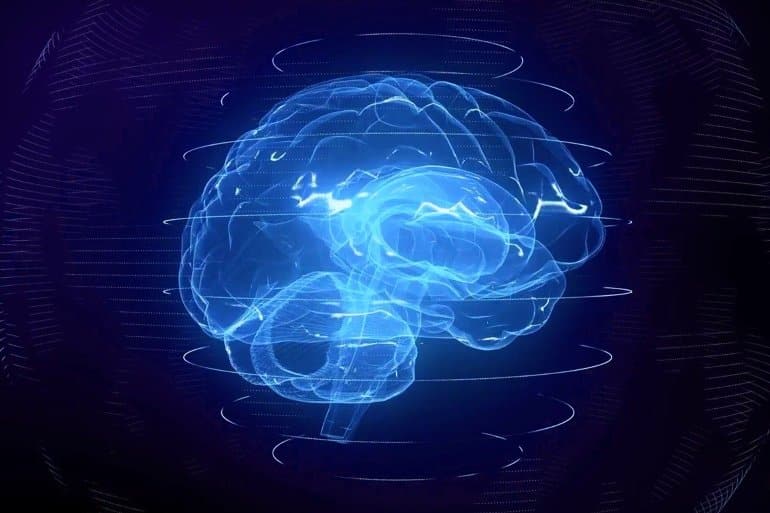Summary: Allopregnanolone, a neuroactive steroid used in the treatment of postpartum depression, alters neural communication in the basolateral amygdala, an area of the brain associated with emotion and mood regulation. The drug may alter the network associated with chronic stress, which may explain its persistent antidepressant effect.
Source: Tufts University
New research led by neuroscientists at Tufts University School of Medicine suggests the prolonged antidepressant effects of allopregnanolone, a neuroactive steroid used therapeutically to treat postpartum depression, may involve the ability of the compound to modify communication in an area of the brain important for mood and emotion regulation.
Drawing in part on work Tufts neuroscientist Jamie Maguire did as a postdoctoral researcher identifying a role of brain-derived steroids as mood regulators in rodent models during and after pregnancy, Sage Therapeutics developed brexanolone, its proprietary formulation of a naturally produced neurosteroid called allopregnanolone.
In clinical trials, one 60-hour intravenous infusion of brexanolone demonstrated a significant and clinically meaningful mean reduction in symptoms of postpartum depression within 60 hours that was maintained for up to 30 days. In March 2019, the drug became the first to receive FDA approval for the treatment of postpartum depression in adults.
In a study recently published online as a pre-proof in Biological Psychiatry, Maguire and researchers from Tufts and Sage examined the effect of a single treatment of allopregnanolone in mice to understand how the compound is able to induce long-lasting effects on mood in the treatment of postpartum depression.
“We were really struck by the persistent antidepressant effects of the medication in the clinical trials, which long outlasted the treatment exposure. These prolonged effects were not well explained by the known mechanisms of action of these compounds,” said Maguire, senior and corresponding author and a Kenneth and JoAnn G. Wellner Professor at Tufts School of Medicine.
“Understanding the potential connection between allopregnanolone and network states in areas of the brain implicated in mood not only could identify the mechanisms mediating the prolonged antidepressant effects of this compound but also could shed light on the episodic nature of many mood disorders.”
Oscillations occur when brain cells fire together in a specific rhythm or frequency and represent local and long-range communication in the brain. Specific frequencies of oscillations in the brain are associated with different behavioral states, like sleeping and waking.
However, in neuropsychiatric disorders like depression and post-traumatic stress, oscillations can be disturbed in areas like the basolateral amygdala, potentially leading to symptoms.
In the current study, the researchers find long-term alterations in network states in the basolateral amygdala following chronic stress, a major risk factor for psychiatric illnesses.

By recording brain oscillations in humans and rodents, the researchers found that the drug could change oscillations in the basolateral amygdala to mirror a healthier state.
They also demonstrated that direct application of the drug in the basolateral amygdala can improve behavior in mice, suggesting that this area is critical in mediating the acute effects of the drug as well as the long-term changes in brain and behavioral states.
“Our results may provide an essential framework for understanding the role of oscillations and associated behavioral states,” said Maguire, who is also a member of the neuroscience and MS in Pharmacology & Drug Development program faculty at Tufts Graduate School of Biomedical Sciences.
“Although there may be many mechanisms involved in altering the brain’s network state, if changing oscillations in the brain can lead to long lasting changes in behavior, this both adds to our understanding of the brain and may be a new strategy for drug therapies.”
First author on the paper is Pantelis Antonoudiou, a research associate in Maguire’s lab at Tufts.
Funding: This work was supported by awards from the National Institutes of Health’s National Institute on Alcohol Abuse and Alcoholism (R01AA026256) and National Institute of Neurological Disorders and Stroke (R01NS105628, R01NS102937) and a sponsored research agreement with Sage Therapeutics. The content is solely the responsibility of the authors and does not necessarily represent the official views of the National Institutes of Health. For conflicts of interest disclosure, see the study.
About this neuropharmacology research news
Author: Lisa LaPoint
Source: Tufts University
Contact: Lisa LaPoint – Tufts University
Image: The image is in the public domain
Original Research: Open access.
“Allopregnanolone mediates affective switching through modulation of oscillatory states in the basolateral amygdala” by Jamie Maguire et al. Biological Psychiatry
Abstract
Allopregnanolone mediates affective switching through modulation of oscillatory states in the basolateral amygdala
BACKGROUND
Brexanolone (allopregnanolone), was recently approved by the FDA for the treatment of post-partum depression, demonstrating long-lasting antidepressant effects. Despite our understanding of the mechanism of action of neurosteroids as positive allosteric modulators (PAMs) of GABAA receptors, we still do not fully understand how allopregnanolone exerts persistent antidepressant effects.
METHODS
We used electroencephalogram (EEG) recordings in rats and humans along with local field potential (LFP), functional magnetic resonance imaging (fMRI), and behavioral tests in mice to assess the impact of neurosteroids on network states in brain regions implicated in mood and employed optogenetic manipulations to directly examine their relationship to behavioral states.
RESULTS
We demonstrate that allopregnanolone and synthetic neuroactive steroid analogs with similar molecular pharmacology to allopregnanolone, (SGE-516 (tool-compound) and zuranolone (SAGE-217, investigational-compound)), modulate oscillations across species. We further demonstrate a critical role for interneurons in generating oscillations in the basolateral amygdala (BLA) and a role for δ-containing GABAARs in mediating the ability of neurosteroids to modulate network and behavioral states. Allopregnanolone in the BLA enhances BLA high-theta oscillations (6-12Hz) through delta-containing GABAA receptors, a mechanism distinct from other GABAA PAMs, such as benzodiazepines, and alters behavioral states. Treatment with the allopregnanolone analog SGE-516 protects mice from chronic stress-induced disruption of network and behavioral states, which is correlated with the modulation of theta oscillations in the BLA. Optogenetic manipulation of the network state influences the behavioral state following CUS.
CONCLUSIONS
Our findings demonstrate a novel molecular and cellular mechanism mediating the well-established anxiolytic and antidepressant effects of neuroactive steroids.






